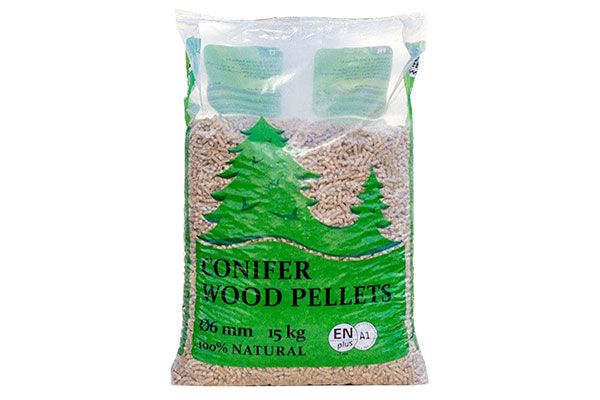Wood Pellets
Wood pellets are made of natural raw wood, i.e., wood particles or sawdust, which are dried, grounded and pressed.
No glue or chemical additives are used for the production of wood pellets.
Wood pellets are an important alternative to fossil fuel because they are ecological, durable, CO2 neutral and are a very reasonable way to process wood waste created during production. It highlights the stable need of wood biomass products worldwide.
Production subdivision of wood pellets makes the following types of pellets:
- 6 mm coniferous wood pellets (ENplus® A1 class)
- 6 mm coniferous and deciduous wood pellets (ENplus® A2 class)
Packaging of Wood Pellets
Wood pellets are usually packed into:
- LDPE 15 kg bags;
- Big bags, 1000 kg each.
Personalised packaging
For traders, packaging into the required design bags is available.
Pellet bags on pallets for transportation are prepared in 70 units (1050 kg in total on a pallet).
A road transportation truck stores 22 pallets.
Marking and certification of wood pellets
The production of wood pellets is standardised and certified.
Certification
A world leading certification system ENplus® guarantees high quality wood pellets.
Certification system is applied to both manufacturers and distributors.
BAGETA pellet production subdivision adheres to strict certification procedures, therefore the compliance of all parameters to the produced wood pellets is guaranteed.
Raw materials for the production of wood pellets
All raw material/logs used in the company BAGETA pellet production are debarked. Sawdust is obtained in the production base, where the production of other wood parts or blanks takes place. Throughout the long years of growing, the bark accumulates dust, so, after its removal, the materials that compose ashes are also removed.
In the production of industrial pellets, we also use shredded wood. Only the highest quality raw materials and its sawdust, chips and shredded wood are used in the entire production chain.
Wood pellets for fuel
Wood pellets is an ecological hard fuel produced from compressed sawdust and related production waste from sawmills, chopped wood.
Central heating boilers of wood pellets are popular due to their convenience for users, easy use and cleanness.
Compared with firewood, wood heating pellets burn hotter and leave less ashes, therefore the final user can spend less time for cleaning the boiler and chimney.
Economic advantages of wood pellets are significant: compared with fossil fuel products and natural gas, you may significantly reduce expenses for heating. Wood pellets central heating boilers, as well as wood pellet heaters turn more than 90 % of fuel energy into suitable heating.
The use of wood pellets not only provides a lot of benefits for the environment, as well as obvious economic advantages for users, but also ensures the future market for companies that participate in this sector and supply fuel, produce heating devices, install them and service them.
Wood pellets for horse husbandry
Conifer wood pellets may be used for horse bedding, it is a great alternative to wood shavings or straws.
Horse bedding pellets quickly absorb liquid and humidity by turning into powdery, soft and comfortable base on the ground. Conifer pellets contain natural resins and oils intended to fight against ammonia by maintaining stable, sweet smell.
Pellets are heat-treated; therefore, they are naturally antiseptic and contain no mold and bacteria.
Wood pellets are a safe choice and provide safe environment for horse hooves and limbs.
Conifer wood pellets are made of high-quality sawdust produced by processing natural raw wood in production department. It is important because the pellets do not contain any chemical additives or waste of furniture wood.
Recommendations for wood pellet storage
High quality pellets are dry and packed in sealed bags for storage and transport. Openly stored pellets quickly and well absorb humidity from the environment. When exposed to moisture, they immediately lose their shape, begin to disintegrate, become loose and are no longer suitable for burning.
It is recommended to store packaged pellets in covered and dry warehouses. If storage outside is chosen, it is important to take care of the tightness of the package, to avoid direct impact of rain.
Even when leaving the package in a dry warehouse, make sure that the package is not torn, check the quality of the pellet (if they still seem to be of appropriate structure, if no loose sawdust is visible).
Tears may be sealed with adhesive tape.
































